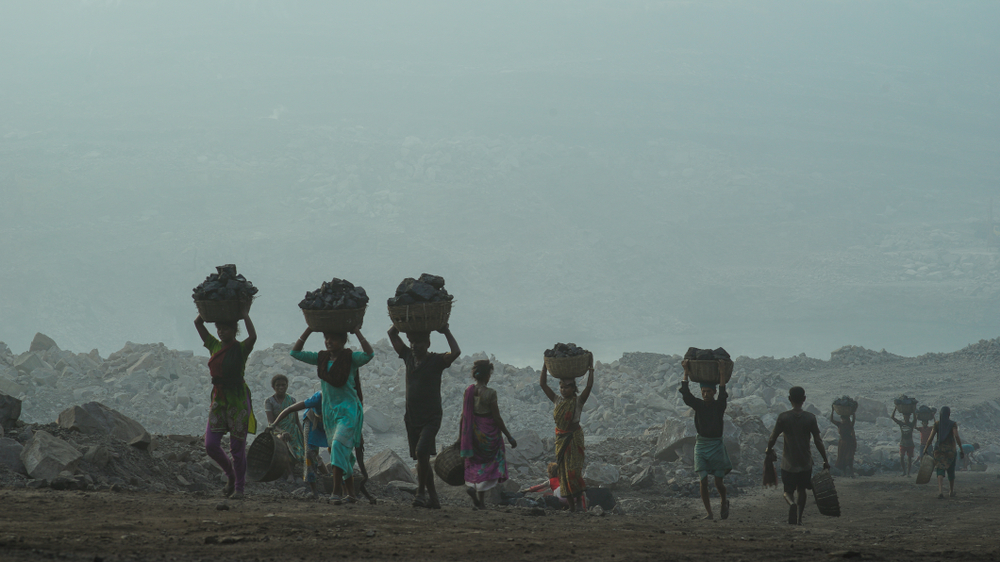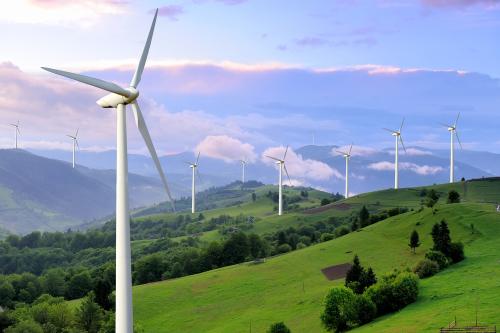Achieving the goals of the 2015 Paris Agreement will be difficult without ultimately phasing out coal in India, among other countries. In March 2020, prior to COVID-19, India had the third largest coal generating capacity in the world. Behind China, India also had the second largest pipeline of new coal plants slated for construction.1
While India is currently only responsible for about seven percent of global greenhouse gas emissions, that share could rise rapidly if India’s pent-up demand for energy is ultimately met through coal-fired electricity. While renewable energy is now less expensive than new coal-fired power across most of India and accounts for the bulk of new capacity installations, coal continues to dominate India’s electricity generation due to the legacy of coal plant construction in previous decades.
In a recent event for the Powering Past Coal Alliance, United Nations Secretary General António Guterres said that to meet the world’s climate goals, all coal plants should be closed in OECD countries by 2030 and everywhere else including India by 2040. He went on to say: “The needs of coal communities must be recognized, and concrete solutions must be provided at a very local level.” Fatih Birol, Executive Director of the International Energy Agency, echoed these concerns: “We need to support, as an international community, those countries and communities who would face serious economic challenges as a result of leaving coal behind.”
However, the Indian government continues to see coal as a source of power generation in the future. Although about 50 GW of coal capacity is slated to be eliminated, new higher-efficiency plants of even greater capacity are being built or in the pipeline. The United States and the international community would need to make an offer persuasive enough for India to change course on coal. A long-standing viewpoint in New Delhi (as other developing country governments) has been that the wealthier countries ought to make good on their commitments on climate finance as a part of the bargain made at Paris.
Whether India can embrace a faster phase-out of coal burning power plants is a critical question for the world. Should India be interested, the United States can support India’s just transition away from coal by mobilizing funding to (1) support coal-dependent communities, (2) repurpose former coal plant and mine sites, and (3) decommission polluting coal-fired power plants. Different financing vehicles from USAID, the newly formed U.S. Development Finance Corporation (DFC), and international banks, like the World Bank, could support different aspects of this strategy. This would also be in the spirit of the commitments made for financial transfers in the Paris Agreement and the United States’ renewed commitment under President Biden to solving global problems like climate change through internationalism and dialogue.
India’s Central Role in Global Climate Policy
India still has large untapped needs for power as the country becomes wealthier and people can afford appliances such as air conditioners. While the COVID-19 pandemic has slowed demand and economic growth, India’s latent power demand could ultimately prove damaging for local air pollution and climate mitigation if met by an expansion of coal-fired power plants.
India’s emissions of carbon dioxide were seven percent of the global total in 2019, the third highest. In per capita terms, though, India was a distant 140th. About 45 percent of India’s energy-related carbon dioxide emissions come from coal-fired power plants. In a recently released report, the International Energy Agency (IEA) estimated that, under currently stated policies (the so-called STEPS scenario), India’s emissions would increase by 50 percent by 2040, the most of any country in the world.
India remains heavily dependent on coal for power generation. Of India’s total installed capacity of 374 GW, 53 percent (200 GW) was fired by coal at the end of 2020. In terms of actual power generation, the figure is actually higher since renewables provide intermittent capacity over the course of the year. In 2018, coal thus provided 74 percent of electricity generation.
India’s coal-fired power generation fleet is also relatively new, with most plants built within the past two decades. Some 60 GW of coal fired power plants are already under construction and another 40 GW in the pipeline, though it is unlikely all of these will be built. Other estimates, however, suggest the capacity of plants under construction and in the pipeline is considerably lower.2 Coal plant building has greatly reduced since 2016, with supply overcapacity and the increasing cost competitiveness of renewable energy. Still, new coal plants continue to be built at a lower rate.
Given how low India’s per capita emissions are, the worry is that India’s future emissions growth pattern could mirror China’s and rise dramatically in a short period of time. China’s emissions were lower than the United States as recently as 2006 and are now nearly double those of the United States. India’s emissions increased by 55 percent between 2000 and 2019,3 before the COVID-19 crisis led to a major decline in economic activity and emissions. But, as Navroz Dubash argued, “If you think [India] will be a China repeat, it’s a fearful story. But it’s actually a huge opportunity.” In choosing a clean energy trajectory, India has the opportunity to reduce air pollution deaths, generate jobs in new sectors, attract global finance, and meet its energy security goals by tapping its extensive solar potential.
While a high growth scenario might lead to a large increase in emissions, slower economic growth, accentuated by the COVID-19 crisis, might also pose a barrier to decarbonization. With slow growth limiting the country’s fiscal resources and contributing to protectionism, India may be unable and unwilling to invest in major decarbonization efforts and reinforce reliance on domestic coal resources.
These observations suggest that India’s intentional, strategic efforts to gradually phasedown its coal fleet will be hugely consequential for the country and the world.
Barriers to an Indian Transition Away from Coal
Multiple barriers exist for a transition away from coal for India.
First, coal is a domestic resource and India has had an energy strategy that has often sought self-sufficiency. India has stressed energy security throughout its history as an independent nation, though it has never been close to achieving this goal, with 28 percent of its coal use and 85 percent of its oil consumption currently sourced from imports. Imported coal often out-competes domestic coal in the country’s coastal plants, which are located far from mines. Nevertheless, the belief that domestic coal resources are an enabler of greater self-reliance is strongly held in the country.
Second, there are major interests tied to coal. These include the state-owned behemoth Coal India, the world’s largest coal miner, with an annual gross revenue of $17.9 bn (INR 1349.8 bn) and a gross profit of $3.2 bn (INR 241 bn) in the fiscal year 2019-20. The giant state-owned Indian Railways also makes a profit from transporting coal from its mining sites to power plants which can be more than 1000 km away. Several state governments such as Jharkhand and Chhattisgarh also depend on coal as a significant source of income and tax revenue.
Third, there remains anxiety over managing variability of renewable energy and integrating it efficiently in the still-inadequate Indian grid. Though the ambitious Green Energy Corridor project has made progress in evacuating far-flung sites of wind and solar generation, it has always remained in catch-up mode with the large volumes of renewables capacity being added.
Fourth, a transition away from coal is further complicated by the weak financial position of India’s electricity distribution companies, which are deeply in the red, with net debt projected to reach more than $62 bn (INR 4500 bn) this year and losses doubling compared to the previous year.4 Since distribution companies (Discoms) have long-term contracts (typically with durations of 20 to 25 years) with coal generators, they are often reluctant to sign new contracts for additional renewables capacity since they still have to pay coal operators even if they don’t secure power from them.5Fifth, pandemic-magnified economic challenges make coal plant closures even more challenging. The COVID-19 outbreak, now in its second and even more destructive wave, has depressed the domestic economy and led to a significant drop in economic growth and employment. This has a number of effects, notably pressure on the government to pursue measures that might generate economic growth and employment, including environmentally damaging activities such as auctions to open up new coal mine sites. Coal plant closures would also erode revenues of some of India’s poorer federal states such as Jharkhand, Chhattisgarh, Odisha, and Madhya Pradesh, where a large number of coal mines and plants are located.
Sixth, economic challenges are compounded by social dislocations from phasing out coal. Jobs and livelihoods for coal miners and plant workers in some of India’s poorest states constitute a direct impact. More than 700,000 Indians are directly employed in coal mining. Many more depend indirectly on coal-fired power generation and industrial use. As many as four million are employed directly and indirectly as per recent calculations. Perhaps as many as 10-15 million benefit from coal through ancillary employment and social programs near the mines. More indirectly, India’s state-owned rail system cross-subsidizes its fares with revenue earned from freight, a large part (45 percent) of which is derived from coal shipments.
Why Should India Move Away from Coal?
Despite these challenges, there are a number of reasons why India would want to move more swiftly away from coal.
First, air quality in Indian cities is some of the worst in the world, and coal burning power plants are one of the major causes. Of the 30 most polluted cities in terms of air quality, 21 were in India in 2019, in part a function of the way pollutants are trapped at the base of the Himalayas in the Indo-Gangetic plain. The University of Chicago estimated that poor air quality is reducing life expectancy in India by more than five years, with residents of the capital region of Delhi losing more than nine years off their life expectancy. In 2019, the IEA said that there were more than one million premature deaths in India from ambient and household air pollution. Another study in The Lancet estimated an even higher total for 2019, 1.67 million deaths or nearly 18 percent of deaths in the entire country. Air pollution they estimated caused $36.8 billion in economic losses or nearly 1.4 percent of GDP. While there are diverse contributors to poor air quality in India including seasonal crop-burning, construction dust, and automobile emissions, burning of coal at power plants is among the important contributors, responsible for about half of sulphur dioxide emissions, 30 percent of nitrogen oxides, and 20 percent of particulate matter.
Second, even without taking into account the health and social costs of coal, electricity from new renewable sources is now often cheaper than coal-fired electricity, particularly in parts of the country located far from the coal mine pitheads. Domestic coal has until recently been a low-cost resource that has discouraged serious planning for a phaseout. This argument is however getting less tenable with time. For instance, in early 2020, as much as 48 percent of coal plant capacity had marginal costs below the levelized cost of the lowest solar bid at the time, which was INR 2.44 or 3.3 cents/kWh. The most recent solar auctions have come at even lower prices – INR 1.99 or 2.7 cents per kWh. The cost advantage implies that India has opportunities to save money by decommissioning dirty coal plants and replacing them with renewable energy.
Third, although the challenges of grid integration are considerable, a recent study showed that up to 26-32 percent of variable renewable (i.e. wind and solar) electricity (and more than 45 percent of non-fossil electricity) can be integrated with minimal additional costs by 2030. This can be achieved using the existing grid through running coal and hydropower plants more flexibly, increasing inter-state power transfers, and some use of battery storage. No additional coal plants would need to be built in the future, according to this analysis. The current wind and solar fraction in India’s generation is just above eight percent, which indicates that there is scope for almost quadrupling the current fraction of renewables generation at a low additional cost.
Fourth, a move away from coal will help end mining-linked organized crime that is a major governance challenge in some of India’s poorest states. The “coal mafia” exploits the industry’s lowest-paid contract workers and engages in violence and pilferage. Many residents of coal-rich parts of India thus suffer from a double-burden: prosperity from mining activities has largely eluded them even as their coal resources have spawned crime and corruption.
How the United States Can Help India Achieve Coal Phaseout
Should the Indian government be receptive, the United States could provide concessional multilateral and bilateral finance to the Government of India to facilitate a just and clean energy transition. These funds would serve three primary purposes:
- Help workers and communities in coal communities receive support during the transition away from coal,
- Support repurposing/rehabilitating of coal plants and coal mine sites for other productive activities,
- Support closure of high polluting coal plants.
Different funding sources might support each aspect. For example, USAID could help support the transition costs for coal-dependent communities while the DFC could provide risk and exchange insurance to private sector companies interested in supporting new economically productive activities at former coal sites. The United States, through funds managed by the World Bank, could help the government of India borrow at lower interest rates than India can secure domestically to support closure of aging, inefficient coal plants.
The Indian government itself in its 2018 National Electricity Plan identified some 48.3 GW of coal plants that were going to be at the end of their life by 2027, with some 22.7 GW slated to close between 2016/2017 and 2021/2022 and another 25.6 GW by 2026/2027. However, the government may be reluctant to follow through on these plans for closure, given potential opposition from regions reliant on coal for income and employment. As a result, government ministries may be divided over whether aging, polluting plants should be closed.
In addition, a 2020 study in Energy Policy estimated that between one quarter and one half of India’s coal fleet (between 50 and 100 GW of the country 196 GW of coal capacity) has higher variable costs than the levelized costs of solar. In other words, the fuel costs for those coal plants are higher than the costs of power from solar plants. With renewables now at cost parity or cheaper than the costs of coal, India could potentially save money by replacing inefficient and relatively expensive coal-burning power plants with even lower cost renewables.
India also has ambitious plans to scale up renewable energy, having expanded its original target of 175 GW of renewable energy by 2022 to 450 GW by 2030. While slow economic growth may diminish India’s ability and need for that extent of capacity additions, the coal sector could face stranded assets from uncompetitive power. In a scenario of heavy renewables penetration, a 2021 study for the Institute for Energy Economics & Financial Analysis (IEEFA) found that the India’s largest power company NTPC, Coal India, and Indian Railways could face major cash flows losses, reaching $9 billion over the next decade.
However, for both aging coal plants and economically uncompetitive plants, the concentrated transition costs in particular areas could lead to political fallout and resistance to closure and would have significant impacts on the lives and livelihoods of those left behind. Prior research notes that Indian coal cross-subsidizes other activities such as passenger rail as well as providing more local benefits in coal communities from employment, tax revenue, and supports for schools and clinics. We also know that the coal production is concentrated in relatively low-income states in the east of the country such as Jharkhand, Odisha, and Chhattisgarh.
With that in mind, the United States, should India be amenable, could help mobilize finance to help India as it seeks to transition to cleaner energy sources by reducing its coal fleet.
Just transition finance for workers and communities
Supporting the transition costs for affected households and communities would make the coal transition both more politically sustainable and just. Here, USAID could be tasked to identify projects that would support the transition in affected communities. This could include transition training opportunities, income support, and investments in schools and clinics in communities in and around plants and mines slated for closure.
Estimating the costs of a just transition would likely require additional study, and USAID could support research to estimate the costs of a just transition and what projects and delivery mechanisms could be implemented. A recent analysis for the Center for Strategic and International Studies made similar recommendations and said U.S. support could help India prepare coal transition readiness assessments, build institutions to guide the process, underwrite skilling programs, and provide direct support for communities.
Sandeep Pai, an expert on the Indian coal sector, noted that there are a variety of ways to think about the communities, constituencies, and benefit streams affected by coal plant closures, including (1) workers, (2) pensioners, (3) corporate social responsibility (CSR) programs that are mandatory for coal companies, (4) the District Mineral Foundation (DMF) that funds local development in mining communities, (5) state level taxes and royalties, (6) federal taxes, and (7) potentially railway subsidies.
Some of these quantities may be easier than others to estimate. Together annual obligations to India’s more than 500,000 coal pensioners, CSR programs, and DMF funds amount to more than $1 billion a year.6 Trying to calculate the other parameters is challenging, but the costs are likely sizable.
External actors would likely only support a portion of the needed funds, and other partners other than the United States could also support the effort. USAID work in the energy space in recent years in India has focused on crowding in private sector funding through the U.S.-India Strategic Energy Partnership (SEP), a program announced in 2018. A $28 million USAID project for regional market development in South Asia was announced in October 2020. SEP included a number of areas for technical cooperation, including work to make Indian coal plants more flexible to be able to ramp and up and down to accommodate the integration of more variable renewable power.
Given the scale of India’s need for just transition finance, a USAID program would likely have to be considerably more ambitious than programs of recent years. Here, the commensurate level of ambition might be something more like the President’s Emergency Plan for AIDS Relief (PEPFAR), the President’s Malaria Initiative, or Feed the Future.
Investment finance
There are potential private sector opportunities to transform coal plant and coal mine sites into new business ventures including small-scale enterprises, tourism, agro-forestry and even local manufacturing of clean energy products such as solar panels, inverters, batteries, and two- and three-wheeler electric vehicles. The latter is particularly important, as it will address India’s concerns about energy independence. Though India is well-endowed with wind and solar resources, most generation equipment is currently imported, with geopolitical rival China as a key supplier.7
The DFC, which replaced the Overseas Private Investment Corporation in 2020, could be tasked to explore opportunities to support U.S. private sector actors that might want to avail themselves of business opportunities in this space, potentially partnering with Coal India and other Indian entities as they seek to diversify their holdings. Coal India is looking to get into solar wafer manufacturing and already has a joint venture to build solar plants.
DFC has a variety of instruments that could be deployed in this space, from political risk insurance to debt financing to technical assistance and feasibility studies to investment funds and equity investments.
In 2020, USAID and DFC were combining efforts to develop a $25 million credit guarantee program to support rooftop solar for small and medium enterprises. DFC also announced in December that it would invest $54 million in equity in India’s National Investment and Infrastructure Fund (NIIF).
Aside from coal site redevelopment, another area of potential public-private investment is in technologies that could replace coal for industrial uses in steel and other sectors. Here, technologies that rely on gas, hydrogen, or even electricity are promising, as is the increased use of recycled steel. Here, a revived form of the U.S.-India Strategic Economic Dialogue could foster cooperation on innovation involving research labs/institutes in both countries.
DFC could also partner with the Indian government, U.S. investors, particularly the Indian diaspora, to explore opportunities for climate-compatible redevelopment opportunities in coal dependent communities. If the Indian government were amenable, this could complement the high-profile renewables investment RE-Invest trade show that has been held three times in India.
Coal plant closure fund
The United States could announce support for a multi-donor World Bank administered Coal Plant Closure Fund, with India intended to be a major beneficiary. That announcement could be included as part of the G-7 to be held in June 2021 or possibly the climate negotiations to be held in Scotland in November 2021. The U.S. could invite other countries to make contributions to the fund.
The new fund could help the government of India borrow at lower interest rates than India can secure domestically to support closure of aging, inefficient coal plants. The Indian government already faces pressures to close aging coal plants and address its air pollution problem. With many coal plants running well below capacity and legacy financial problems in its distribution companies, India will need to inject considerable resources into this sector regardless.
Lower public sector borrowing costs provides an opportunity for India to save money over time by paying off coal investments and loans. This strategy is a way to buy down polluting assets and replace them with cleaner sources of electricity.
There are different ways of realizing the same objective, from green bonds to reverse auctions, securitization broadly captures the idea that a new loan is taken out that is collateralized by the government with the promise of future repayments from customers of the utility. These strategies have ample precedents in the United States, Europe, and indeed in India itself.
One option would be for the Indian government to sell bonds to international investors. The Indian government historically can borrow at eight percent, though the 10-year yield on government bonds has been 6.2 percent. Previous research suggests that the yield for private sector debt and equity investors has been about 9.5 percent and 19 percent respectively, suggesting that the cost of Indian government borrowing to issue bonds would be attractive.
Ideally, the new World Bank-administered fund would enable India to secure even lower interest rates than what it could get by selling bonds.8
This may be attractive to the Indian government and coal plant operators, particularly since many of them are operating at well below capacity. Climate change and pollution concerns may make it more likely that some of these facilities become stranded assets. However, energy analysts are somewhat skeptical that the World Bank and India would find this mutually attractive. The World Bank faces restrictions on financing the coal sector, even for plant closure. India for its part would feel some pressure to rationalize its energy sector which it might feel would pose too much of a constraint on its sovereignty.
Since ¾ of India’s coal plants are inefficient sub-critical coal technology and are highly polluting, they have high emissions of air pollution alongside high emissions of greenhouse gases. In response to the air pollution crisis affecting much of the country, the Indian government in December 2015 required power plants to install pollution control equipment, so called flue gas desulfurization equipment, by the end of 2017, although that deadline was extended to 2019 and then later extended for different regions to as late as 2022. Even then, 70 percent of India’s coal plants may fail to meet those standards in 2022.
By one estimate, these retrofits would cost the coal sector between $10 billion and $35 billion, which could help reduce emissions of sulphur dioxides and other pollutants but not carbon dioxide. Given the delays in meeting these standards, operators might favor early phaseout of those assets rather than having to pay for expensive retrofits.
The World Bank has experience supporting other countries with the coal transition. In 2018, the World Bank announced a multi-hundred million dollar UK and Canada-funded effort to support the Energy Transition and Coal Phase-Out Program, intended to slow coal production in Asia. In 2019, the World Bank launched another program, Support to Energy Transition in Coal Regions, with early projects in the Western Balkans and Ukraine as well as existing work in China, Poland, South Africa, among other countries. Some of the funding for these programs supports a just transition including worker support during the transition and transformation of coal sites for productive use after closure. Here, the World Bank is working with the European Union which has a EUR 17.5 billion Just Transition Fund, with some EUR 3.5 billion to be allocated to Poland for its coal transition.
Having invested $83 billion over the last five years in climate-related programming (26 percent of its commitments), the World Bank has already said that it intends to make sure 35 percent of its projects offer climate co-benefits over the next five years. As such, the U.S. may be able to initiate a dialogue with India, the World Bank, and the wider international community if a major multilateral effort of concessional finance would be attractive.
Conclusion
India faces growing pressure this year to announce new climate commitments, in line with other major emitters. A low-carbon future is only plausible if India has a plan for the coal sector and gets the kind of financial assistance it has long since called for to make it a reality.
Ultimately, this will be India’s choice, but the international community could play a role in supporting the transition with concessional finance.
The Rocky Mountain Institute estimated that 17 percent of India’s coal fleet is currently not cost competitive with solar and storage. By their calculations, that 17 percent could be phased out now saving $2 billion annually, with the remainder requiring $23 billion in concessional finance to immediately phaseout. That percentage that is not competitive will rise to 50 percent in 2022 and 85 percent in 2025. By 2025, the net savings would be $15 billion a year.
As the coal sector faces rising financial challenges, India will have to grapple with how best to manage its energy transition. The process for coal phaseout will likely take decades, but it perhaps could proceed faster than it otherwise might with support from external actors.
That support would not only help mobilize resources and know-how to assist the Indian government, but those resources in turn would help diminish the risks of political fallout from affected communities and address core equity needs, while not detracting from India’s energy security.
There will likely be short-term closures of coal plants as the Indian government has already envisaged. However, how that process plays out is subject to debate. Some scholars caution against blanket approaches that would close plants of a certain age. They note that older subcritical plants might be useful for flexible and firm power resources that would rarely run but be useful to compensate for renewable power at the extremes of its intermittency. Since many older plants are fully amortized and paid for and located near the pitheads, these plants could be run for relatively low cost. By running them rarely, their net environmental impact might be low. Subcritical plants may be easier to adapt to flexible runs than newer more efficient plants.
These are obviously choices for the Indian government to make. That said, the U.S. could assist with technical support from its national labs to help the Indian government identify what is the fastest pace India can phase out a large fraction of its coal power without compromising the need for grid stability and enhanced energy access for its citizens.
There are steep challenges of getting the US Congress to appropriate more money to international causes, but if the Biden administration recognizes the coal transition challenge to be that important, then it would inevitably need to identify new funding streams like those that President’s Bush and Obama mobilized for programs such a PEPFAR, the President’s Malaria Initiative, and Feed the Future. There is already significant funding for India and energy in India from USAID, and existing funding streams could support this effort. Moreover, the Biden administration will likely try to plus up funding for climate mitigation and international development to fulfill campaign promises and address global expectations. Recognizing the challenge of Congressional appropriations is precisely why we combined our recommendations for USAID finance with DFC and World Bank resources.
One final consideration, during the Trump administration, much of the energy-related focus was on expanding fossil fuel exports to India, including oil, gas, and coal. India had been the largest destination for U.S. coal exports, but exports tumbled by more than 60 percent between quarter 1 and 2 of 2020 as India sought to replace coal imports with domestic coal. Any effort by the Biden administration to support India’s coal phaseout should not be accompanied by an effort to push export of U.S. coal, though there may be some considerations related to India’s lower quality coal and Indian industrial sectors’ need for higher quality coal.
In sum, with different financial instruments and proactive policies, the United States can help hasten India’s transition away from coal by making an attractive offer which also ensures that the needs of coal dependent communities are met – a win for India, the U.S.-India partnership, and the world.
Sarang Shidore’s time was supported by the UT Energy Institute as part of the Fueling a Sustainable Energy Transition (FSET) initiative. Other than the aforementioned, the authors did not receive financial support from any firm or person for this article or from any firm or person with a financial or political interest in this article. They are currently not an officer, director, or board member of any organization with an interest in this article.
-
Footnotes
- According to Carbon Brief, India had about 11 percent of the world’s installed capacity and 13% of planned coal plants compared to 49 percent and 41 percent in China. According to End Coal, India had about 16 percent of the world’s planned plants compared to 61 percent in China.
- Global Energy Monitor suggests India has 37 GW under construction and 29 GW in the pipeline.
- India’s CO2 emissions fossil fuels and cement (excluding land use) rose from 1.7 gigatonnes (GT) in 2010 to 2.6 GT in 2019.
- Using exchange rate of 1 USD = 72.59 INR as of March 24, 2021.
- Coal contracts in India typically consist of two parts – a fixed component designed to pay the plant’s capital costs and a variable part linked to fuel costs. Even if no power is purchased from the plant, the distribution company buyer is obligated to pay the fixed component of the contracted cost.
- Sandeep Pai, “Personal Communication,” March 3, 2021.
- Shrimali and Jindal estimated the costs and benefits of decommissioning a typical coal plant in India and repurposing of plants to some combination of solar energy and battery storage. They found favorable cost-benefit ratios, particularly direct value from scrap value and indirect benefits from carbon reductions.
- Though a new fund might charge different interest rates than the Bank’s typical lending terms for India, existing rates provide an indication of what those terms might be. The Indian government can borrow from the World Bank at the 6 month LIBOR (currently 0.21%) plus some transaction fees of about 0.5% and an additional amount depending on the length of maturity of the loan between 0.5% and 1.5%. The Bank also has a Special Development Loan category which has a higher interest rate of LIBOR + 2% plus a 1% front end fee.
The Brookings Institution is committed to quality, independence, and impact.
We are supported by a diverse array of funders. In line with our values and policies, each Brookings publication represents the sole views of its author(s).









